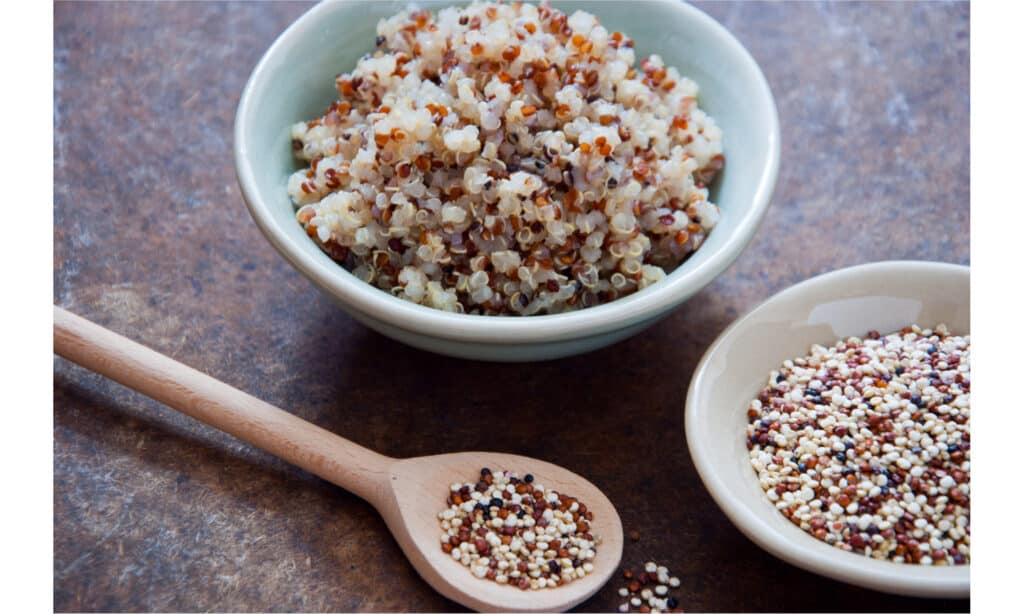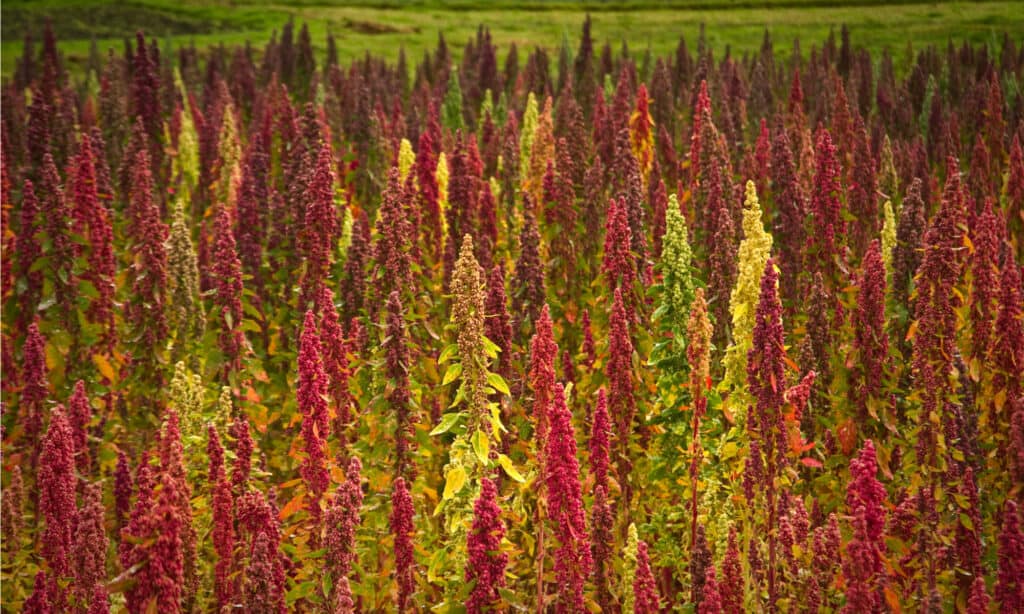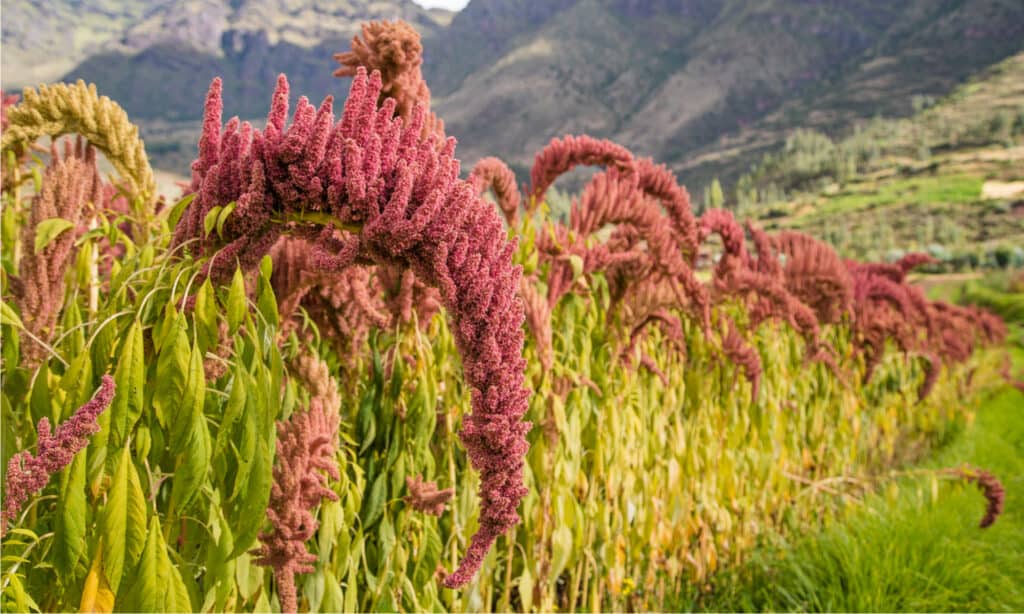Both ancient grains with a number of nutritional benefits, there are undeniable similarities between amaranth vs quinoa. However, what might the differences be between these two plants, and how can you learn how to tell them apart? Whether you’re a fan of these grains for their culinary uses or plan on growing them yourself, there’s a lot to love about them both!
In this article, we will compare and contrast quinoa and amaranth so that you can gain a full understanding of both grains. Not only will we cover the physical description of both of these plants, we will also go over their uses and tastes. Let’s get started and learn all about amaranth and quinoa now!
Comparing Amaranth vs Quinoa

| Amaranth | Quinoa | |
|---|---|---|
| Classification | Amaranthus; Amaranthaceae family | Chenopodium quinoa; Amaranthaceae family |
| Description | Grows up to 6 feet tall on green or red stems. Wide leaves can be green or red as well, with many veins. The stems end in a unique flower with multiple stalks that occasionally drape down, covered in small grains or seeds. Found in a variety of colors, including red, orange, and green, though the grain itself is tan. | Grows 3-9 feet tall with spinach like leaves. The tall stems end in poofy seed clusters, found in a variety of colors (red, green, yellow, orange, purple, white, brown, black). Stems stand very erect and do not droop, though some varieties branch out. Looks like a type of grass or wheat when seen in the wild. |
| Uses and Nutrition | Extremely nutrient dense and offers a lot of vitamins per serving. Commonly eaten as a pseudocereal, but also ground into flour. The entire plant can be eaten. | Very nutrient dense and gluten free, making it ideal for people with an intolerance. Can be used to make flour, beer, or soup, and is often eaten instead of rice in high protein, calorie-deficit diets. The entire plant can be eaten. |
| Hardiness Zones | 2-11 | 4-10 |
| Taste and Texture | The entire plant has an edible sweetness to it. The leaves taste similar to spinach, and the seeds are nutty. Even after being cooked, the seeds maintain a slightly crunchy texture. | Quinoa seeds taste nutty and relatively bland, allowing you to flavor as needed. The texture is chewy and unique, and you can eat the entire plant. The leaves have a mild taste as well, with some sweet notes. |
Key Differences Between Amaranth vs Quinoa

The flower of the amaranth comes in fewer colors compared to the vibrant quinoa flower.
©iStock.com/letterberry
There are many key differences between amaranth and quinoa. Both quinoa and amaranth belong to the Amaranthaceae family, but they are different species. Quinoa plants grow taller than amaranth plants on average. The flower of the amaranth comes in fewer colors compared to the vibrant quinoa flower. Quinoa seeds are larger compared to the small seeds found in amaranth. Finally, amaranth grows in more hardiness zones compared to the average quinoa plant, likely because quinoa has a longer growing season.
Let’s take a look at all of these differences in more detail now.
Amaranth vs Quinoa: Classification
While both amaranth and quinoa belong to the same family, they are in fact different species. Belonging to the Amaranthaceae family, amaranth is classified as Amaranthus, while quinoa is classified as Chenopodium quinoa. Both of these plants are technically pseudocereals rather than grains, given that their seeds can be used in a variety of ways.
Amaranth vs Quinoa: Description

Depending on the age of the plant and the variety, quinoa typically comes in red, green, orange, purple, white, and black, while amaranth only comes in red, orange, and green.
©veggie only/Shutterstock.com
It can be difficult to tell an amaranth apart from a quinoa plant just by looking at them. However, there are a few distinct differences between them that you can learn to keep an eye out for. For example, the amaranth flower sometimes droops very distinctively, while quinoa plants remain erect all the way up, to the colorful flower at the end.
Speaking of color, quinoa comes in far more colors compared to amaranth. Depending on the age of the plant and the variety, quinoa typically comes in red, green, orange, purple, white, and black, while amaranth only comes in red, orange, and green. Finally, the average quinoa plant grows taller than the average amaranth plant, and sometimes reaches 9 feet in height!
Amaranth vs Quinoa: Uses and Nutrition

Amaranth grows in more hardiness zones compared to quinoa, and quinoa has a longer growing season compared to amaranth.
©Fotos593/Shutterstock.com
Both amaranth and quinoa are prized for their nutrient dense compositions, though there are a few differences between them in this respect. For example, amaranth has slightly more protein content compared to quinoa. In addition, amaranth has nearly double the amount of iron compared to quinoa as well. However, they are both fantastic rice alternatives, offering more vitamins, minerals, and nutritional value in comparison.
Given their popularity and overall health benefits, quinoa and amaranth have extremely similar uses. They both cook for relatively the same amount of time, though amaranth takes slightly longer than quinoa. For the most part, quinoa is more widely used compared to amaranth, and you can even find beer made from quinoa!
Amaranth vs Quinoa: Hardiness Zones
If you are planning on growing either quinoa or amaranth, there are a few important things to know about their preferences. For example, amaranth grows in more hardiness zones compared to quinoa, and quinoa has a longer growing season compared to amaranth. To go into detail, amaranth can grow in hardiness zones 2 through 11, while quinoa can grow in hardiness zones 4 through 10.

Quinoa has a much more neutral flavor compared to amaranth, though quinoa can get bitter if you do not rinse it before eating it.
©Davis Dorss/Shutterstock.com
Amaranth vs Quinoa: Taste
The final difference between quinoa and amaranth lies in their taste. Quinoa has a much more neutral flavor compared to amaranth, though quinoa can get bitter if you do not rinse it before eating it. You can eat both of these plants in their entirety, from leaves to roots, though the seeds are the preferred culinary item. When cooked, quinoa maintains a chewy texture, while amaranth has a crunchy and nutty taste.
The photo featured at the top of this post is © Fotos593/Shutterstock.com
Thank you for reading! Have some feedback for us? Contact the AZ Animals editorial team.






